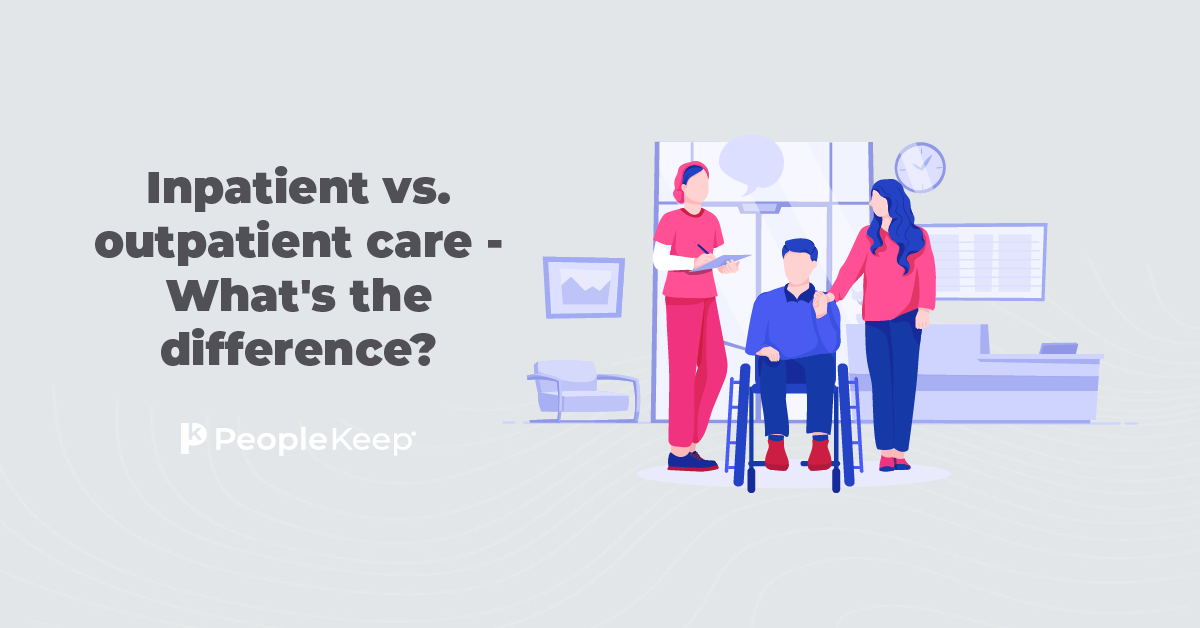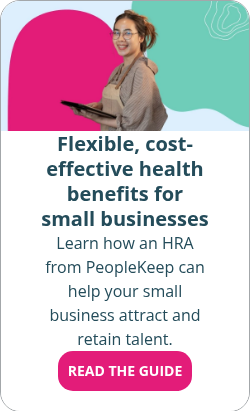What is healthcare consumerism?
By Chase Charaba on December 17, 2024 at 2:00 PM
Healthcare consumerism has emerged as a growing trend in the healthcare industry. Thanks in part to rising healthcare costs, more people feel the need to take charge of their own health. They want the best bang for their buck when it comes to health and wellness services.
Healthcare consumerism, once slow to grow, is now the norm in many areas of the industry. But what is healthcare consumerism, and how does it affect employee health benefits?
In this article, we'll explain the rise of healthcare consumerism. We’ll also explore health benefit options that empower employees to take control of their healthcare decisions.
In this blog post, you'll learn the following:
- Why healthcare consumerism is beneficial.
- The key factors driving patient engagement.
- The different health benefits employers can provide to promote consumerism in healthcare.
Defining healthcare consumerism
Healthcare consumerism is a movement in which individuals take more control of their healthcare decisions. This growing patient empowerment allows healthcare consumers to be more conscientious of their health benefits and associated costs. Now, consumers demand more control and responsibility for the healthcare resources they use, including the health plans they and their families enroll in.
For employers, this usually means employees have a hands-on role in paying for and managing their medical benefits. Generally, this results in better healthcare services for the consumer. It can also reduce overall costs. This is because people are more willing to assess the value of the services they’re utilizing and make informed decisions about their care.
In essence, patients act more like consumers who are shopping for a product to buy online. Like any other product or service, they want affordable options for their healthcare that provide measurable value.
Why is healthcare consumerism a good thing?
Healthcare consumerism pushes the entire healthcare industry to provide better information and transparency. This ensures everyone can make informed decisions about their health and health benefits.
Recent changes that address consumer behavior include introducing hospital reviews, telehealth, and other remote healthcare choices. There's also an online library of health information from healthcare organizations and hospitals. This need for increased transparency has even resulted in Congress passing new legislation: the No Surprises Act.
The No Surprises Act, which took effect on January 1, 2022, helps to protect Americans from surprise medical bills at out-of-network hospitals or other providers. This helps to reduce out-of-pocket costs and medical debt in the U.S.
All these medical service changes resulted from healthcare consumerism. But why is the trend growing in the first place?
What is driving healthcare consumerism?
While healthcare consumerism isn't a new concept, it has been growing in popularity.
Some early drivers behind healthcare consumerism include:
- Value-based care. A 2023 Health Care Payment Learning & Action Network report1 shows that about 60% of healthcare payments from the previous year incorporated a quality or value component.
- The popularity of high deductible health plans (HDHPs). A Gallagher survey2 found that 53% of employers offered a HDHP in 2023.
- The direct-to-consumer (DTC) marketing of medications. In 2022, the pharmaceutical industry spent about $7.6 billion3 on DTC advertising in the U.S. That’s nearly a 6% increase from 2021.
According to a MediMedia article4 in the U.S. National Library of Medicine, patients began to participate in medical decision-making with healthcare providers in the 1980s. Then, in 1997, the FDA changed the healthcare landscape. It relaxed rules on broadcast advertising for medications. Pharmaceutical companies began to advertise directly to consumers about drugs and medical procedures.
The Affordable Care Act (ACA) further encouraged healthcare consumerism. It allowed individuals to compare and buy individual health insurance policies on a public marketplace.
COVID-19 was also a factor. Since the pandemic, almost two-thirds of Americans5 are more concerned about their health and wellness. Healthcare consumerism accelerated as individual patients sought new ways to connect with their healthcare providers, such as through telehealth or concierge medicine. Others switched healthcare providers to receive more personalized coverage for their unique needs, such as chronic conditions. This resulted in improved patient experiences.
With more healthcare options available than ever before, many consumers are abandoning traditional health insurance companies in favor of newer plans and insurance alternatives.
What can employers do to promote consumerism in healthcare?
According to our 2024 Employee Benefits Survey, 92% of employees consider health benefits important. But offering health coverage to your workers is just the start.
Employees want more control over their benefits. This means employers need to provide flexible benefits options.
Employees won't only be looking for low-cost benefits. They'll also be looking for easy-to-use personal health benefit experiences. To plan for consumerism in healthcare, organizations need to offer accessible and transparent employee health benefits.
Traditional group health insurance plans don't offer an individualized healthcare experience. Your employees have different needs, and offering a single insurance plan gives them no say in their health benefits. For example, your group plan may not cover their preferred doctors, specialists, or prescription medications.
Thankfully, there are other options for providing your employees with quality health benefits while giving them more control and flexibility over their healthcare costs. In the following sections, we'll cover alternative medical care benefits that provide an individualized consumer experience.
Stand-alone health reimbursement arrangements (HRAs)
One flexible health benefit option is a health reimbursement arrangement (HRA). An HRA is an employer-provided arrangement for reimbursing employees for their healthcare expenses.
HRA allowances are tax-free. Employees can use their allowance on qualified medical expenses. This includes insurance premiums and out-of-pocket expenses. Employers offer these allowances monthly, and any unused funds stay with them at the end of the benefit year.
Some examples of HRA-eligible expenses include:
- Preventive care
- Emergency care
- Prescription drugs
- Over-the-counter medication
It works like this: your employees submit expenses for reimbursement. This can include individual insurance coverage premiums. You approve their eligible expenses and reimburse them up to their available allowance amount. You usually reimburse employees through their paychecks.
Employees must provide proof of eligible expenses. This ensures that your employees use their allowances for healthcare expenses. It also grants them the freedom to choose their individual health insurance policy and which out-of-pocket healthcare costs they want to receive reimbursement for. This gives your employees complete control over choosing a primary care provider based on their needs and budget.
With an HRA, your employees have the flexibility to use their health benefit in the way that works best for them.
There are two popular types of stand-alone HRAs:
- Individual coverage HRA (ICHRA): The ICHRA offers the most flexibility for employers. They can differ allowances and benefit eligibility with 11 employee classes, such as full-time or part-time workers. Employees need their own individual health insurance policies that provide MEC to participate in the benefit.
- Qualified small employer HRA (QSEHRA): Unlike the ICHRA, the QSEHRA is only for small businesses with fewer than 50 full-time equivalent employees (FTEs). The IRS also sets annual contribution limits for the QSEHRA. Employees can participate in the QSEHRA with any type of MEC coverage. This includes coverage through a parent’s or spouse’s group health insurance plan.
Account-based health plans
Flexible spending accounts (FSAs) and health savings accounts (HSAs) are also popular options that give employees more control over their health benefits. Both FSAs and HSAs are tax-advantaged spending accounts where employees can set aside funds from their paychecks to cover out-of-pocket expenses.
Employees own HSAs, giving them complete control over their accounts and health expenses. You can also contribute to an employee's HSA.
However, not every group health insurance plan supports an HSA. Your employees need an HSA-qualified high deductible health plan (HDHP) to contribute to an HRA. And, because your employees own their HSAs, they can take the funds with them when they leave your organization. Many employees use their HSAs as an extra retirement fund instead of a health benefit.
Like an HSA, an FSA is a spending account that both employers and employees can contribute to. Unlike an HSA, though, the funds in an FSA aren't maintained if your employees leave the organization. This gives employees more financial incentives to use their funds for healthcare.
Health stipends
The final type of health benefit we'll cover is a health stipend. Like an HRA, you can offer your employees a health employee stipend to help them cover their health and medical expenses.
Health stipends aren’t formal benefits, so they have fewer regulations than HRAs, HSAs, or FSAs.
Your employees can use their health stipend allowance on many expenses, including:
- Mental health benefits
- Supplemental insurance products like dental and vision
- Personal hygiene products
- Specialized care for certain health conditions
Because health stipends aren't tax-advantaged, you must add them to your employees' W-2s as taxable income. This makes stipends an excellent option for organizations with employees who receive premium tax credits. Your employees won't need to waive their credits to take advantage of the health stipend benefit.
However, a health stipend doesn’t satisfy the ACA’s employer mandate for applicable large employers (ALEs). An ALE has to offer an ICHRA or group health plan to maintain compliance with federal laws. They can offer a health stipend in addition to either of these health benefits.
Conclusion
Healthcare consumerism is changing the medical landscape and increasing patient satisfaction. Health benefits must also adapt to meet growing consumer demands. Understanding and following healthcare consumerism trends will increase employee satisfaction and reduce turnover. You'll also create a more meaningful benefit that works for your employees' individual needs by offering your employees flexible health benefits.
HRAs are a great option for providing flexibility to your employees while still ensuring that they use their benefits for health expenses. With PeopleKeep's personalized benefits solutions, you can provide your employees with the benefits they want.
This blog article was originally published on March 16, 2022. It was last updated on December 17, 2024.
Check out more resources
See these related articles

What is healthcare reimbursement?
Looking to reimburse your employees for their healthcare expenses? Learn everything you need to know about healthcare reimbursement.

What is an hour bank arrangement for healthcare?
Wondering what an hour bank arrangement is in healthcare? This article breaks down the concept and how it functions within the construction industry.

Inpatient vs. outpatient care - What's the difference?
Curious about the difference between inpatient and outpatient care? We break down the key distinctions to help you make informed healthcare decisions.



